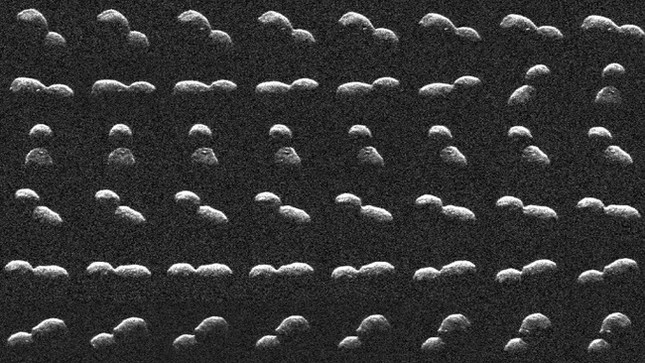TPO - The latest close-up images reveal the snowman shape of the "potentially hazardous" asteroid 2024 ON, which safely passed Earth on September 17.
 |
The "potentially hazardous" asteroid 2024 ON looks like a snowman in radar images captured by the Deep Space Network's Goldstone Solar System Radar. (Image: NASA/JPL-Caltech) |
NASA scientists have released fascinating images of an asteroid that flew past Earth last week — revealing it to have a strange, rolling snowman-like shape.
An asteroid called 2024 ON safely flew by our planet at a distance of 1 million kilometers — about 2.6 times the distance between the Moon and Earth — on September 17. The asteroid was traveling at a speed of 31,933 kilometers per hour, 26 times the speed of sound.
New images taken by the Goldstone Solar Radar near Barstow, California, USA, show the skyscraper-sized asteroid. Asteroid 2024 ON is actually two asteroids locked together by their own gravity into a binary star after they came too close to each other.
Other famous contact binaries include Selam orbiting the asteroid Dinkinesh in the main belt between Mars and Jupiter, and Arrokoth, an icy object beyond Pluto's orbit that has been studied by NASA's New Horizons probe since 2015.
No danger to the Earth
“This asteroid is classified as potentially hazardous, but it does not pose a threat to Earth in the near future. These Goldstone measurements have allowed scientists to significantly reduce the uncertainty about the asteroid’s distance from Earth and its future motion over decades,” NASA wrote.
NASA considers any object in space that comes within 7.5 million kilometers of Earth to be “potentially hazardous,” even if it doesn’t pose a direct threat to Earth. That’s because even slight impacts to such an asteroid’s orbit—like hitting another asteroid—could send it on a collision course with Earth.
NASA tracks the positions and orbits of about 28,000 asteroids by scanning the entire night sky every 24 hours. The space agency has found that Earth is not in danger of an apocalyptic asteroid impact for at least the next 100 years.
According to Live Science
Source: https://tienphong.vn/tiet-lo-hinh-anh-tieu-hanh-tinh-khong-lo-vua-luot-qua-trai-dat-post1676159.tpo






















![[Photo] National Assembly Chairman Tran Thanh Man visits Vietnamese Heroic Mother Ta Thi Tran](https://vphoto.vietnam.vn/thumb/1200x675/vietnam/resource/IMAGE/2025/7/20/765c0bd057dd44ad83ab89fe0255b783)













































































Comment (0)